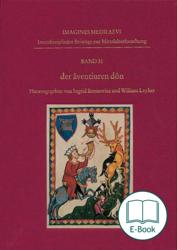The contributions in this volume assess the value of the acoustic in the Middle Ages and evaluate its importance in medieval literature. Although a great deal of research in Medieval Studies has focused on issues related to visuality, there has never been an in-depth study of the significance of auditivity in medieval courtly culture. The implications of sound and hearing have likewise remained unexamined. The essays (from John Greenfield, Harald Haferland, Susanne Knaeble, Andreas Kraß, Claudia Lauer, William Layher, Sylvan Wagner and Viola Wittmann) face the challenge of recovering that which seems to have faded away: the audible Middle Ages. Using a rigorous approach to examine acoustic phenomena and their reception in medieval texts and the cultures that produced them, this volume presents new insights about the richness of cultural production in the Middle Ages.
In recent years the concepts “visuality” and “visual culture” have established themselves as leading paradigms in contemporary Medieval Studies. And this for good reason. The innate performativity of courtly interactions and the complex relationships between text and image in illustrated manuscripts make it clear that the Middle Ages was a fundamentally visual epoch.
And yet, there are a number of other interpretive approaches that can be applied to the literature of the Middle Ages and Early Modern era, and these should no longer be overlooked. Important questions must be asked, for example: What role did hearing play in courtly representation? Is there an auditory counterpart to the concept of the gaze in the Middle Ages? To what extent could sound be a vehicle for cultural engagement? Building on these questions, the research presented here focuses on the literary representation of acoustic events in order to engage in new ways with central texts in the German medieval tradition, such as the Parzival of Wolfram von Eschenbach, the Tristan of Gottfried von Straßburg, Laurin and Reinhart Fuchs.
The contributions in this volume assess the value of the acoustic in the Middle Ages and evaluate its importance in medieval literature. Although a great deal of research in Medieval Studies has focused on issues related to visuality, there has never been an in-depth study of the significance of auditivity in medieval courtly culture. The implications of sound and hearing have likewise remained unexamined. The essays from John Greenfield, Harald Haferland, Susanne Knaeble, Andreas Kraß, Claudia Lauer, William Layher, Sylvan Wagner and Viola Wittmann face the challenge of recovering that which seems to have faded away: the audible Middle Ages. Using a rigorous approach to examine acoustic phenomena and their reception in medieval texts and the cultures that produced them, this volume presents new insights about the richness of cultural production in the Middle Ages.
This series, which will comprise doctoral and professorial dissertations and other monographs as well as collective volumes, aims at highlighting and promoting interdisciplinarity in Medieval Studies even more than is currently the case. Works from all branches of Medieval Studies will be accepted, provided they emphasise the aspect of interdisciplinarity, i.e. they attempt to transgress the boundaries of any single subject.


 Preface
Preface